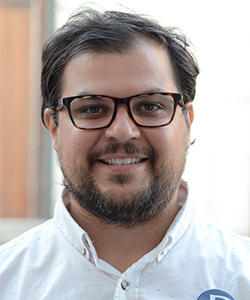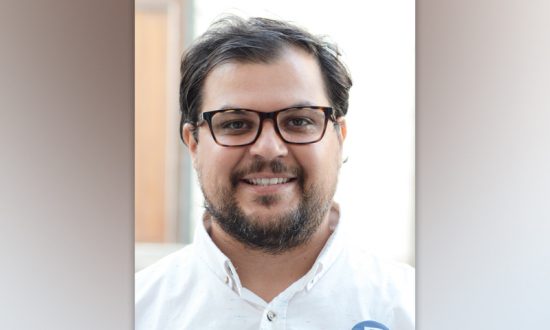Emiliano Pereiro has a bachelor’s degree in sociology at Universidad de la República, Uruguay and a master’s degree in educational policy at Universidad Torcuato di Tella, Argentina. He is the head of computational thinking unit at Plan Ceibal, a unique innovation agency in that reaches out the entire Public School System in Uruguay, from K5 to 9ht grade providing Technological Infrastructure, Teacher Training, Contents and Learning Platforms as well as Project Based Learning Opportunities for Students to foster the inclusion of technology as leverage for learning, from a New Pedagogies Perspective.
In this new digital reality, many countries seek to introduce Computational Thinking (CT) into their curricula in its variety of definitions and heterogeneities of intervention. To understand how a computer works, its language (apart from having a basic use of a computer) becomes a fundamental competence that every person should know to develop digital citizenship skills.
In my opinion, nowadays, we are going through a societal change that is almost as radical as the one lived through in the first industrial revolution. The world is becoming increasingly digital, and the pandemic is accelerating this change. The economy is digital. In the last 15 years, the best-valued companies changed their profile, while in 2005, oil companies and tangible goods companies led the world rankings. In 2020, algorithms were the protagonists, and technology companies were the best valued. But not only has the economy, but citizenship is also becoming more and more digital. Countries like Estonia already allow you to apply for an E-Residency. Policy discussions in the coming years will be focused on artificial intelligence and its regulation, ethical and moral discussions that we as citizens must give, chatbots teachers, intelligent life assistants, the resurrection of the dead with digital identity. All this is already happening. Future citizens must incorporate these skills and knowledge, just as at one point in the industrial revolution, all citizens had to learn to read and write to understand the world around them. Today it is time for all of us to learn Computational Thinking.

Computational Thinking in Uruguay
Ceibal develops the Computational Thinking concept in different educational approaches, but since 2017 it started to implement a specific Computational Thinking program with a small pilot in 30 public urban schools. In 2021 the program has almost 2000 groups, 30,000 students and 1300 classroom teachers distributed in almost 60% of the total number of public urban schools in the country. ANEP1 and Plan Ceibal2 lead this implementation.
The Computational Thinking program is inspired by the successful pedagogical model of the videoconference English teaching program, “Ceibal en inglés”. The pedagogical model of the program incorporates a remote teacher who has expertise in computer science, programming, and CT. The remote teacher connects to the videoconferencing equipment installed at the schools and teaches in partnership with the classroom teacher.

This model has three main aspects:
Remote teaching: The teacher of Computational Thinking is not physically present, just as in other forms of distance teaching. Unlike distance teaching, however, students are in a group of approximately 25 children, in their own classroom, in their school, with their classroom teacher.
Team teaching: Team teaching is an approach in which two or more teachers are jointly responsible for course content, lesson activities and assessment. Remote and classroom teachers can only teach by mutual cooperation.
Blended learning: Blended learning is a form of formal education in which a student learns in part through online delivery of content and instruction. In the Computational Thinking blend of teaching, the RT teaches remotely, the CT does so face to face, and all use an LMS, called CREA.
1 National Public Education Administration https://www.anep.edu.uy/
2 https://www.ceibal.edu.uy/en/institucional
3 Ceibal en Inglés Methodology Statement https://n9.cl/kzxoq

Ceibal, in its practice, approaches a definition that considers computational thinking as the ability to recognize aspects of the real world that can be modelled as problems and to design and evaluate algorithmic solutions that can be implemented computationally (Fraillon et al., 2019). That is, computational thinking is understood as a way of reasoning and solving problems from the logic of coding and computing.
In this framework, students are expected to develop the main contents of Computer Science and learn new approaches to problem-solving by taking advantage of the potential of computational thinking in order to be users and creators of today’s and tomorrow’s technology.
In the last survey conducted by Ceibal’s evaluation and monitoring department, 91% of classroom teachers stated that the program should be universalized to the entire educational system, and 97% would recommend the program to a colleague.

What are the keys that we found and learned for an educational policy based to be so successful in the educational community?
- The technology infrastructure which has been installed since 2007 in Uruguay through the implementation of the Ceibal Plan: Technology in the classroom is a reality for Uruguayan teachers: all students have a device and internet connection, and video conferencing equipment is installed in every school. Uruguayan teachers have been using technology in the classroom for 14 years, are familiar with it and are therefore inclined to adopt this type of approach.
- Optative participation in the program: It is not mandatory for teachers. It is a bottom-up builded policy. This way of implementing the program does not generate resistance in the community because it is a collective construction.
- By taking into account the voice of the educational community, we work closely with teachers and listen to their feedback. The voice of the teachers is very important to be able to make sensitive decisions in order to improve the program.
- Interdisciplinary pedagogical approach: Computational thinking works in an interdisciplinary way with other areas of knowledge, specific CT contents such as algorithms, AI, sequences, abstraction with contents of language, mathematics, science and art, among others. The interdisciplinary nature of the proposal is a key factor in achieving greater acceptance of the proposal; the sequence of activities is related to the different areas of knowledge and curricula. In this way, a teacher who participates in the program can work on mathematics, language and science as curricular content through Computational Thinking.
- Teacher training and support: The Computational Thinking program has a specific line of training that includes conceptual modules on CT, didactic modules where these concepts are put into practice in classroom lesson plans and technical modules related to the use of coding languages. This line of teacher education is based on instructional design. In addition, there is a group of people from our staff working onsite, in the schools, distributed throughout the country, that is responsible for coaching the teachers participating in the program, conducting specific workshops on TC and identifying their needs.
- Use of accessible and scalable technology: The program uses Scratch and Micro: Bit to work on CT, low-cost technology and designed for pedagogical use. These technologies are designed specifically for pedagogical purposes, they are accessible to both teachers and students, and their low cost allows them to be massively used.
- CT curriculum and achievement levels: A CT curriculum provides a framework to work with the students with an introduction to the fundamental knowledge that they need to learn in order to become well educated digital citizens and defines learning objectives. Research on state of the art in the discipline was conducted and a framework for the work of Computational Thinking in Uruguay was elaborated. This framework is still under construction and in the process of validation with authorities and the educational community.
- Pedagogical leadership: Implies an active teacher who co-designs with other actors in the educational community, like a remote teacher, for example, but also with other teachers.
- Evaluation and monitoring: Measure to make evidence-based decisions. We evaluate the quality of the pedagogical content, the perception of the teachers who participate in the program, and we are working to evaluate learning. In this line in 2020, Uruguay joined the Bebras Challenge (an international initiative to promote CT). The program has an area dedicated to the quality of teaching computational thinking.
- Gender perspective: Several studies have shown that in the world of technology, there is a gender bias, males are overrepresented, and the program has an active policy to try to change this problem. The program works specifically to reduce the gender gap that exists in the discipline.
- Research and development: The CT team promotes, develops and uses research in the field and new technological tools that allow for new and innovative pedagogical approaches. The Computational Thinking concept is still under construction in the world. For this reason, it is key to have a constant research perspective to keep up with the changes.
- Alliances: The program has formed different alliances with actors in the country and the region linked to the subject, such as the Sadosky Foundation of Argentina.
Due to the successful implementation at the primary level, the program is moving forward in its expansion to secondary education. In May 2021, 100 mathematics teachers will lead the first experience, working in CT and Math, also in proposals that include machine learning and artificial intelligence.
About Emiliano Pereiro

In 2020, Emiliano Pereiro was invited as a speaker for AI and the Futures of Education. Developing Competencies for the AI Era at Unesco. In 2019, he was a member of the team of authors of the World Bank publication “Skills and the Labor Market in a New Era: Managing the Impacts of Population Aging and Technological Change in Uruguay”. In 2019 published an article in Cetic Brasil “A comparative analysis of the digital skills of children in Brazil and Uruguay”. In 2018, he was chosen by The IDB-INTAL to participate in a study on the future of social employment. In 2018 he was a teacher at the Torcuato di Tella University in Argentina. In 2016 he co-founded the pansophia project, a platform for research on the education of the future.




